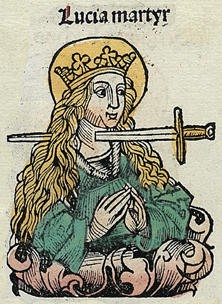St Lucy's Day (13 December) is celebrated by the Swedes with yeasted buns called Lussekatter. Along with other Nordic peoples, they have more than one reason for partying on this day, which falls one week before the hibernal solstice.
 |
| Santa Lucia - Nuremberg Chronicle, 1493 |
Santa Lucia
Lucia of Sicily was of noble descent, a Christian who refused to marry a heathen. The man betrayed her to Diocletian's governor who threatened to put her in a brothel as was the Roman law but she miraculously escaped the punishment and died honorably in 304. She is venerated on 13 December -her dies natalis- by Catholic, Lutheran & Orthodox Christians alike. Medieval representations of her depict a woman in prayer whose throat is -unsuccessfully- being pierced by a sword. She is also portrayed next to St Agatha whose life example she followed or alone, carrying a pair of eyes: St Lucy is not only the patron of virgins but, due to her name which is derived from light (lux), she is also the patron of sight. A fascinating story in praise of her courage explains how she once aided her persecuted brothers by fixing candles on a wreath that she put on like a hat. She thus managed to free both hands and carry large quantities of food & wine. This became a very popular image in Sweden where Christian faith spread after the year 1000.
Lucia of Sicily was of noble descent, a Christian who refused to marry a heathen. The man betrayed her to Diocletian's governor who threatened to put her in a brothel as was the Roman law but she miraculously escaped the punishment and died honorably in 304. She is venerated on 13 December -her dies natalis- by Catholic, Lutheran & Orthodox Christians alike. Medieval representations of her depict a woman in prayer whose throat is -unsuccessfully- being pierced by a sword. She is also portrayed next to St Agatha whose life example she followed or alone, carrying a pair of eyes: St Lucy is not only the patron of virgins but, due to her name which is derived from light (lux), she is also the patron of sight. A fascinating story in praise of her courage explains how she once aided her persecuted brothers by fixing candles on a wreath that she put on like a hat. She thus managed to free both hands and carry large quantities of food & wine. This became a very popular image in Sweden where Christian faith spread after the year 1000.
The longest night of the year
St Lucy's Day almost coincides with the hibernal solstice in the Julian calendar. This was (& still is) a very important date that people all over Europe celebrated with feasts, dances and poems like the '-Nocturnal upon St. Lucy's Day, Being the Shortest Day' by the Renaissance master John Donne (1572-1631):
Lucy's, who scarce seven hours herself unmasks;
The sun is spent, and now his flasks
Send forth light squibs, no constant rays;
The world's whole sap is sunk;
The general balm th' hydroptic earth hath drunk,
Whither, as to the bed's-feet, life is shrunk,
Dead and interr'd; yet all these seem to laugh,
Compared with me, who am their epitaph
In Sweden, a place that's greatly affected by the cold & dark atmosphere of the Nordic winter, the day marks the beginning of the Christmas season - just as Lussinatta (the night between 13 & 14 December) used to mark the beginning of Yuletide. Both celebrate the sun's rebirth although the pre-Christian 13 December was centred around an evil spirit of female gender who rode through the night with her followers: trolls, witches & other dreadful creatures. According to custom that is still being kept, the Swedes throw parties until the early hours or stay awake at home watching out for Lussi, who slides down chimneys to punish those who neglected difficult tasks in the previous year.
A message of hope
On 13 December 1796, a man had a vision of a young girl singing in the middle of the night. She was dressed in white and holding a candle, and he thought it was St Lucy. People who listened to his story received the message that warmer, lighter days were coming soon. It soon became tradition for a girl in every house (usually the eldest daughter) to dress in white and bring the family steaming coffee & buns. She wears a crown studded with lights and is followed by other girls, all dressed in white and singing the carols. The scene is acted to this day by pretty blonde heads although the Swedish illustrator Fritz von Dardel (1817-1901) had a different idea about the popular event.
In any case, Lussekatter (or Lussekat, if you'd rather make one loaf of bread) is counted among the gastronomic delights of the season. In Sweden they are sold as early as November but it's on 13 December that people around the world remember Santa Lucia.
ST LUCY'S BUNS
This is a modern version of the classic sweet bread recipe. The use of buttermilk and sour cream is arbitrary; Lussekatter can be made with any combination of liquids (whole milk, buttermilk, sweet or sour cream).
I n g r e d i e n t s
675g strong flour
1 sachet dry yeast
pinch of salt
200ml buttermilk
200ml sour cream
125g butter
125g caster sugar
0,2g saffron powder
2 eggs, lightly beaten
raisins (for decoration)
M e t h o d
V a r i a t i o n
Mix 100g raisins into the dough before the second proofing.


Comments